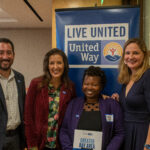Search
New Study Reveals Giving Disparities
August 30, 2023
Understanding Disparities and ReThinking Resources

By: Kelly Batson, UWBA Chief Community Impact Officer
At United Way Bay Area (UWBA), our hopes and dreams to break the cycle of poverty in our communities are big, but our resources and capacity are never quite what we wish they were. We know this is true not only for ourselves, but also for our nonprofit neighbors in the eight counties we serve across the Bay Area.
We have seen studies in the past about these disparities. The study published by Applied Survey Research (ASR) and First 5 Solano County in 2016 about the inequitable funding for Solano County is one example. An update to that was also published in 2018.
So, when we wanted to understand where the high-need areas are, in terms of poverty, for the Bay Area and overlay that with philanthropic giving data, we knew just where to start – our friends at ASR. Because we are focused on fighting poverty across the Bay Area, we needed to know – do community needs line up with the distribution of philanthropic giving? With this information, we can maximize the resources we do have. By “we,” I mean all of us.
Over the last year, we worked with ASR to analyze poverty, unemployment, and housing burden data, as well as foundation giving data from 2018 – 2020 to focus on those zip codes that have been left out of equitable resources as part of our Understanding Poverty and Philanthropic Giving Disparities report. Here’s what we found:
- There are high-need ZIP Codes in every county.
All counties we serve have attributes that qualify them as having moderate or high-level needs related to economic stability, and every county has ZIP Codes that have a needs score of 31 , the highest score possible in the study. - Not all high-need counties are funded equitably.
Between 2018 and 2020, about 182,080 grants totaling $26 billion were given to agencies in the Bay Area2 . While there are high-need ZIP Codes in every county, these funds were most heavily concentrated in just three – Alameda, Santa Clara, and San Francisco Counties. - Funds distributed in each county do not reflect needs or population density in each county.
While San Francisco County only accounts for 12% of the Bay Area population, organizations in San Francisco received 38% of the funding in the Bay Area. By comparison, Marin, Napa, and Solano Counties make up about 12% of the Bay Area population combined, but only account for about 3% of the funding distributions. - While the number of grants increased between 2018 and 2020, the average amount per grant decreased.
The number of grants distributed to agencies and organizations in the eight Bay Area counties grew from 73,000 in 2018 to more than 94,000 in 2020. The amount of grant funds distributed to agencies and organizations in the eight Bay Area counties decreased from more than $10.6 billion in 2018 to a little more than $9 billion in 2020.
I started at the United Way of the Bay Area (yes, we used to have that “of the”) in 2006 as a Program Associate for our Free Tax Help program (formerly known as Earn It! Keep It! Save It!). It was early in my nonprofit career, but it didn’t take me long to figure out that we work in a world of limited resources.
This is why, today, I’m most excited about is the opportunity to take action as an organization, to examine our programs and initiatives, and to ensure we are reaching those most in need with those limited resources. We are also extremely excited to share this report with the community at large, including, but not limited to, the philanthropic giving community.
We have included 10 opportunities for action at the end of the report. SPOILER ALERT – Two of those opportunities include:
- Invest more in Solano County and
- Invest more.
Period.
We need to grow the whole pie, not withdraw investments from one county to give to another. Something tells me there is more than enough to go around.
We know that the inequities in giving and the inequities in communities are linked, and it is going to take all of us to shift towards an equitable Bay Area where everyone has the resources and opportunities they need to thrive. It’s time to act…differently!
We hope you will check out the full report here. When you’re done, jump over to our donation page to help us ensure resources are available for all Bay Area communities.
You can also use our dashboard to look more closely at the community needs.
________________________
2. The distribution of funds by geography represents the location of organizations receiving funds, not necessarily the reach of those organizations to serve a broader community.


